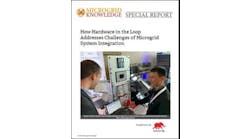More manufacturing companies are gaining interest in deploying microgrids to help them operate through power outages and serve as community stewards.
Tor Anderson, Power Engineers
In the past, industries were looking for on-site generation, often through combined heat and power (CHP). These include companies such as food and beverage manufacturers, refineries and tire manufacturers, for example.
Now, these industries have more goals. They want to integrate technologies such as solar and batteries so they’re capable of disconnecting from the grid and creating resilience. They’re also interested in being seen as good stewards of their local communities, said Tor Anderson, vice president of engineering for Power Engineers’ generation division, in the Microgrid Knowledge Executive Interview Series.
“Industries are very interested in having projects that they can be proud of, those that reduce carbon and improve their reliability and operations,” he said.
As a result, more and more projects that start as CHP become microgrids. This trend is happening in many areas of the country, even those that have historically had low electric prices, based on coal, natural gas or hydro.
“We expect to see this trend growing and create opportunities for microgrid implementation. Companies that are making products and don’t see themselves as power generators are becoming more receptive to sustainability initiatives, whether it’s coming from the plant needs or from corporate directives,” said Anderson.
Superstorm Sandy in 2012 and the Texas storm in February that crippled the state’s power system created more interest in microgrids. In addition, some companies have had a hard time accessing natural gas supplies for their boilers and generators as a result of storms and wildfires. Industries are now seeing the technology as more sensible and economical.
“We’re seeing that a lot of things are coming together to create an interest in microgrids. There’s continuing awareness that if you lose power it’s costly. The economics are getting better. And people are trying to reach their sustainability goals,” said Anderson. Companies also want to know that their investments are good for their future and for their communities.
As a result of these benefits, perception of microgrids is changing. Companies see that the technology can help them meet their core mission — producing their products as efficiently as possible.
Meanwhile, avoiding outages has become more and more important.
Placing a value on resilience is simpler for manufacturers who can calculate the hourly cost of downtime when a grid outage occurs. For other types of businesses, it’s not always as simple, and there’s an ongoing effort in California and other states to create a technique for calculating the value of resilience.
Power Engineers, an engineering firm, is often involved in a microgrid project from its conception through commissioning and operations. The company will identify technology, provide cost estimates, complete a design, and support contractors. One of its microgrid projects was for Marathon Petroleum, which needed to provide reliable power to its Mandan Refinery in North Dakota and continue operating during power outages. The refinery relied on a single line for power, leading to numerous expensive outages. Power Engineers created a better connection to the utility and a microgrid that could island.
Power Engineers conducted a feasibility level study and cost estimate before performing detailed engineering on the microgrid.
Convincing potential clients of the benefits of such microgrid projects has become easier in recent years, said Anderson.
“Customers just have to be convinced that it’s a good deal for their operation, for their future and for their community,” he said.
Track news about microgrids for manufacturing. Subscribe to the free Microgrid Knowledge Newsletter.







